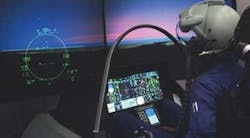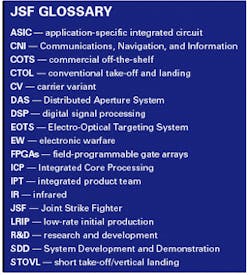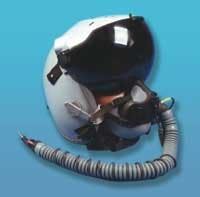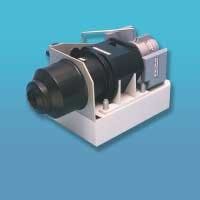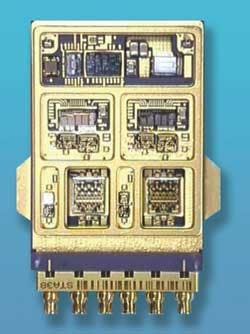The Joint Strike Fighter's sensors, communications, and flight-control systems will blend together more tightly than any other combat aircraft in history, and will revolve around high-speed fiber-optic databuses and powerful commercial off-the-shelf microprocessors.
null
The future U.S. F-35 Joint Strike Fighter (JSF) is set to usher in an entirely new era of avionics design as the aircraft's builders plan to bring the new aircraft's electronic and electro-optic systems integration to a level never seen before.
To get there, the Lockheed Martin JSF will expand on a change in the nature and definition of avionics that has been evolving for nearly a decade in such jet fighters as the Lockheed Martin F-16 and the Boeing F/A-18, but which achieved its most prominent level in the Lockheed Martin U.S. Air Force F-22 Raptor.
Officials from Lockheed Martin Aeronautics Co. in Fort Worth, Texas, the JSF prime contractor, describe this new avionics paradigm shift as "the break from federated architecture to integrated architecture."
This new design approach breaks avionics into two categories: mission systems and vehicle systems. The former includes tools that help the aircraft do its job, such as sensors, displays, and weapons. The latter are subsystems that help the aircraft function correctly, such as power generation, cooling, and flight control.
"Some things that are now electronic on an aircraft were never really considered avionics — fuel systems and such," says Dave Jeffreys, manager of the JSF improvements and derivatives group at Lockheed Martin. "Everything that once was considered avionics is now part of mission systems, but mission systems is a bit broader to include weapons systems. That really began on the F-22."
The F-35's avionics, however, takes another step in redefining avionics by blending an increasing number of hitherto separate subsystems into ever-more-tightly integrated packages. "The JSF is very different from the aircraft it is replacing — the F-16, F/A-18, F-14, AV-8B, A-10 — or even the Eurofighter," Jeffreys says. "They also have federated architectures, but with nothing close to the Communications, Navigation, and Information (CNI) system of the JSF, which will implement half a dozen different physical links to different ships and aircraft."
Redefining avionics
The F-35 has nine key performance parameters, one of which is interoperability. "This aircraft has 144 information exchange requirements that specify the digital transactions that have to occur between the JSF and all other US and allied aircraft in the theater," Jeffreys says.
Previous aircraft designs incorporated individual boxes for almost every system, linked to a central computer via a MIL-STD-1553 1 megabit-per-second serial avionics databus. The F-22 was the first to have a more fully integrated native architecture, built around a high-speed serial databus, which was able to get the most use of those assets without adding more boxes and electronics. That approach also eased the sharing of assets at a relatively low level of integration.
"Every time you do something that complex, you get a little smarter when you finish. So we brought a lot of experience from the F-22 and incorporated those lessons into the JSF, making it a little more efficient," Jeffreys says. "But it is philosophically very much like the F-22 architecture. And some of those improvements will be back-fit into the F-22 downstream." Lockheed Martin builds the F-35, as well as the F-22.
"We have stood up a very disciplined process to do that — what we call 'proven path'. That takes the best state-of-the-art at the time and moves it to available platforms that can utilize it," Jeffreys says. "The majority of our proven-path activity is trying to commonize the F-22 and the F-35 wherever we can. We believe there is a lot of opportunity there."
Fourth-generation radar
Bob Thompson, director of JSF combat avionics systems at Northrop Grumman Electronic Systems in Baltimore says JSF, for example, will incorporate fourth-generation radar technology (compared to the F-22's third-generation system developed a decade earlier) to reduce costs and weight. Northrop Grumman is responsible for the JSF's radar and two electro-optical systems — the Distributed Aperture System (DAS) and the Electro-Optical Targeting System (EOTS) — and is part of aircraft's BAE Systems electronic warfare (EW) team.
"JSF embodies more components of the mission systems than in previous tactical aircraft," Thompson adds. "They all have radars, some have EOTS, but it is usually a pod, such as LANTIRN [Low Altitude Navigation and Targeting Infrared for Night], where in JSF it is internally mounted in the nose. The DAS is an all-new concept that evolved out of the world of missile-warning systems, but it is new here. All attack aircraft have an EW system, of course. It is growing what is in other tactical aircraft to accomplish the missions laid out for the JSF, which is both air-to-air and air-to-ground.
"The DAS is clearly a unique capability, where you are providing the pilot with an IR sphere around the airplane to do missile warning, navigation functions, night vision and so on. The EOTS isn't new, but the way it is implemented as an internal system, supporting both air-to-air and air-to-ground, is a big step forward. The radar is an evolution from the F-22, which itself was a huge evolution in technology over what had gone before, but F-22 was built to do air-to-air missions only, so we had to add the air-to-ground functionality for JSF."
The processor system is being designed with redundancies to protect against a single point of failure. The architecture uses processor cards that closely resemble their commercial counterparts, with redundant cards distributed throughout the architecture to allow loads to switch off in the event of a failure.
Centralized processor
The use of a centralized data processor to handle all on-board sensors on the F-22 was unique at the time, providing an opportunity for a relatively high level of integration, fusion, and one point of control for the mission systems and communication to the pilot. JSF, the most ambitious effort ever undertaken to create a common multi-service aircraft capable of performing so many diverse missions, has continued that basic architecture with a centralized signal and data processor.
The U.S. Air Force will use the F-35-CTOL (conventional take-off and landing) version of the JSF primarily an air-to-ground variant to replace or augment the F-16 and A-10, and to complement the F-22. While the engineering requirements for the Air Force, the largest customer, are not as complex as the other variants, the demand for significant improvements in capability and cost over the F-16, are especially complex.
Replacing the Navy's F/A-18E/F Hornet fighter-bomber as a multi-role, stealthy carrier-based strike fighter, the F-35-CV (carrier variant) will require considerably stronger internal structures and control changes from the Air Force version. Even more striking will be the engineering demands for the Marine Corps F-35-STOVL (short take-off/vertical landing) version, which is to replace the AV-8B Harrier hoverjet and the F/A-18A/C/D strike fighter.
The UK-STOVL supersonic version that will replace the Sea Harrier in the British Royal Navy and the Royal Air Force GR-7 will most closely resemble the U.S. Marine Corps variant.
Officials in the Joint Strike Fighter Program Office estimate the Navy will require 480 aircraft, the Air Force 1,763, the Marines 609, and the United Kingdom (U.K.) 150 — a total of 3,002 F-35s for those primary customers (entering service between 2008 and 2012), with a potential additional demand for as many as 2,000 aircraft for other allies, such as Italy, Australia, Denmark, The Netherlands, Norway, Canada, and Turkey — all of which already have agreements with the U.S.
Diversity in missions
Despite such diversity in missions, Jeffreys and John Harrell, who leads the Lockheed Martin tactical information systems integrated product team, say the mission systems will be virtually identical in the original production models as well as in all future upgrades and block versions.
"Although they have different missions, the functionalities required to do them tend to overlap," Harrell explains. "And it's a lot cheaper to design one set of functionalities to meet all missions and amortize it over 3,000 aircraft than to do individual systems."
Lockheed Martin's vision for the F-35 is to elevate the pilot from system operator to tactician, using the JSF's uniquely integrated and sophisticated mission systems and avionics to identify and strike fixed and moving targets in dangerous environments, day or night, in all weather, and at long ranges to reduce exposure to enemy defenses. Those systems include:
- precision targeting using passive and active sensors at high altitudes and long ranges;
- rapid transition between air-to-air, air-to-ground, and electronic attack operations;
- complete spherical situational awareness of threat aircraft and missile launches;
- precision day/night attack using laser-guided weapons
- accurate attack in all weather using so-called "J-series" weapons such as the Joint Standoff Weapon (JSOW) and Joint Direct Attack Munitions (JDAM);
- communication to more than 100 other platforms or systems;
- suppression/destruction of enemy threat systems augmented by an on-board electronic attack capability;
- multi-tiered sensor fusion for a common operational picture of the battlespace;
- system management allowing the pilot to focus on tactics instead of systems; and
- helmet-mounted display, panoramic head-down cockpit display and 3-D audio to help the pilot absorb the "big picture."
"The real focus was to come up with a balanced system that could address the needs of the three U.S. services and the U.K.," Thompson says. "The real challenge for JSF was to do that while also addressing affordability and supportability, which were the two big drivers, then wrapping all that in an airplane that has to do vertical take-offs and be stealthy. Those are very different thrusts than we had with other aircraft. The real plug for JSF is taking all the sensors and CNI and integrating them into the aircraft as a real 21st-century platform."
Systems evolution
Steve Bryant, director of JSF programs at Northrop Grumman, says the aircraft incorporates a pre-planned technology evolution, starting with LRIP (low-rate initial production) and continuing through full production timeframes.
"We are trying to take advantage of technology as it evolves in the commercial marketplace rather than just live with it," he says. "This is a whole new approach.
"The core architecture, the functional architecture, Lockheed has put together does allow sensors to be integrated from a functionality standpoint, making it very adaptable to bringing in a new sensor," Bryant says. "In reality, you are bringing in new data and integrating it to get new information. As we look forward on JSF and try to envision the future for growth options, we believe the architecture has been very well done to make growth much easier to work."
In March, the Harris Corp. Government Communications Systems Division in Melbourne, Fla., completed its first delivery of hardware under a $68 million advanced avionics design contract from Northrop Grumman. That delivery included fiber optic transceivers and electronic module thermal cores to support development testing on elements of the aircraft's central computing system. The transceivers provide four channels of data transmission and reception at a data rate of 2 gigabits per second (Gb/s) over the aircraft's extensive fiber optic network.
In addition to designing the basic avionics architecture, the contract — which Harris officials estimate could be worth as much as $2 billion over the life of the program — calls for the design and production of image processing and digital map software, fiber optic physical layer components and interconnects, high-speed communications data links, and other components, including power supplies, RF backplanes, custom racks, circuit cards, connectors, and portions of the CNI system.
Fiber optics
Although the JSF has been called the first all-fiber fighter aircraft, Lockheed Martin's Jeffreys says that is slightly exaggerated: "We're not all-fiber — we still have a requirement to take care of some legacy systems that use the 1553 copper interface. We definitely have moved into fiber in a big way, however, more than any previous aircraft.
null
"Fiber has facilitated interaction between the boxes," Jeffreys continues. "When we can do RF over fiber, a lot of the coax cabling will go away and that will have a major impact on weight savings. We're hoping that will be available in several years for one of the block upgrades, but it probably won't be available during Blocks 1 through 3."
He also says JSF's developers have had to consider the influence — and future viability — of Moore's Law. First stated by Intel co-founder Gordon Moore in 1964, Moore's Law says the computing power of a given microchip — or the power available for a given price — will double every one to two years. In recent years, that has been generalized to mean a quantum leap in microprocessor technology takes place every 18 months.
"The military doesn't drive the technological state-of-the-art in much of the electronics areas these days. In the past, we struggled to fit everything we needed to do into the size of processor and speeds we had and how to get all those bits over the interfaces we had. With the processors we have now and fiber interfaces, that is no longer a concern," Jeffreys says. "Now the problem is how to manage and design good, trouble-free software and test all the lines of code involved. So now that we have all the processing and bandwidth we need, we have to make sure we can use it and not design ourselves into a corner.
"Another difference with JSF is we have learned well the lesson that Moore's Law can work against you if you don't pay attention," Jeffreys continues. "So we have designed for technology refresh, so at the appropriate time we can stop putting in the 1 GHz processor board and swap out to the 2 GHz board without having to go back and do any redesign. We were once required to use a MIL-STD-1760 processor with Ada or other military languages; now we use commercial PowerPC with C++."
null
null
Engineers from Mercury Computer Systems in Chelmsford, Mass., are
providing the signal-processing systems for the Integrated Core Processing (ICP) system, JSF's central computer, which supports all of the embedded computing elements for several different aircraft subsystems, including digital signal processing (DSP) for the sensors and cockpit displays. Mercury experts say the ICP will make best use of the modularity and scalability of commercial technology to provide commonality, interoperability, and affordable long-term life-cycle support, including insertion of future emerging technology.
Mercury's RACE++ Series PowerStream MP-510 computer systems are designed into the JSF System Development and Demonstration (SDD) phase.
JSF computers
The computer being used for development is the Motorola PowerPC with AltiVec microprocessor. Vince Mancuso, corporate marketing vice president at Mercury, says chip's combination of high-performance architecture and low power make the PowerPC a good choice for such an embedded real-time application.
"We have to be integrated at both the lowest and highest levels because technology will change over time, so the architecture must continue to evolve to meet needs in the timeframes needed," Mancuso says. "Lockheed Martin has picked an architecture that can help span multiple applications, such as radar, EW, and fire control. In the past, there had been specialized computers for many of these functions.
"In terms of system design, because of the extremely long life that is anticipated — 30-plus years — the team has anticipated multiple upgrades and changes, with an extensive use of COTS and leveraging the R&D investment from the commercial market into JSF," Mancuso says." That also means close coordination among the supply chain team members. By using this common architecture, the plane should have a higher degree of flexibility in its applications, being able to switch from EW to fire control or placing more processing power in different areas, depending on what the plane needs to do."
null
Lockheed Martin's Harrell says there actually are two types of processing modules on JSF — general purpose and signal.
"Mercury is working primarily on the signal-processing module. The signal-processing module runs most of the sensor software; the general-purpose processor runs more mission management software. They are co-located on the aircraft in a common rack," he says. "In general, there are similar levels of redundancy, but implementation is different, which goes back to the federated versus integrated architecture."
Jeffreys says the capitalization of commercial technology in JSF is "one of our major enabling technologies, making it work for us rather than against us."
"We are really trying to get out of the ASIC [application-specific integrated circuit] business. Those are real trouble from a lifecycle cost and supportability view," he says. "We are trying to get more to FPGAs [field-programmable gate arrays], which also lets us be more flexible about the modules we design into the system. That actually gives us fewer discrete modules, which also translates into lifecycle cost savings."
While noting it is too early to tell what influence the JSF development effort will have on other programs in the future, Mancuso says he does believe it has tremendous potential to influence military and commercial developments down the line.
"As we go farther into the 21st century, we will need to see more performance with less weight," he says. "JSF is a big enough program that I believe it will have some impact on component decisions in the future. The needs of JSF are so large that, at the time it goes into full-volume production, people will be designing things into their componentry to meet JSF requirements. It won't change the dynamics of commercial versus defense (development), but incremental changes will be probable."
